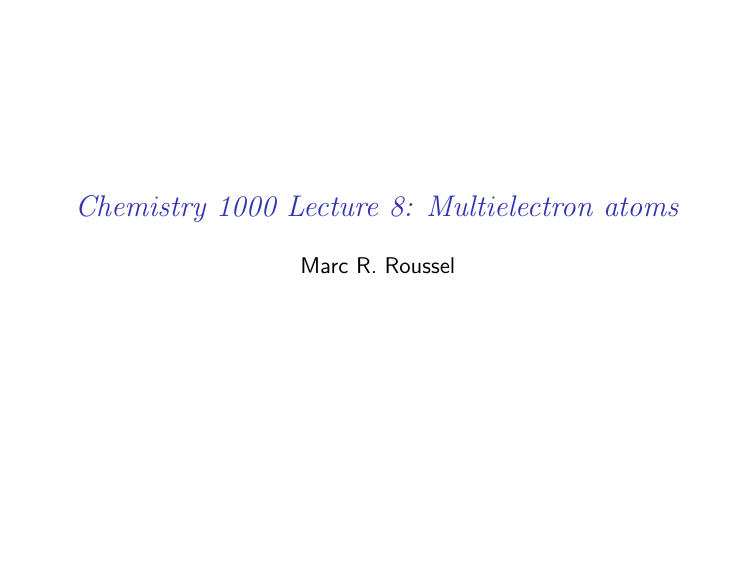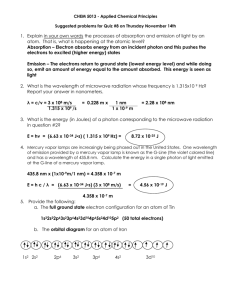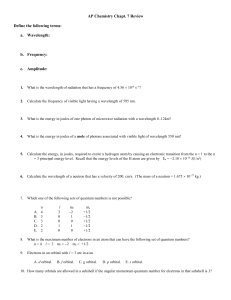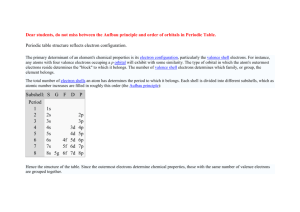Chemistry 1000 Lecture 8: Multielectron atoms
advertisement

Chemistry 1000 Lecture 8: Multielectron atoms Marc R. Roussel Spin I Spin (with associated quantum number s) is a type of angular momentum attached to a particle. I Every particle of the same kind (e.g. every electron) has the same value of s. I Two types of particles: Fermions: s is a half integer Examples: electrons, protons, neutrons (s = 21 ) Bosons: s is an integer Example: photons (s = 1) Spin magnetic quantum number I All types of angular momentum obey similar rules. I There is a spin magnetic quantum number ms which gives the z component of the spin angular momentum vector: Sz = ms ~ I The value of ms can be −s, −s + 1, . . . , s. I For electrons, s = 1 2 so ms can only take the values − 21 or 12 . Stern-Gerlach experiment How do we know that electrons (e.g.) have spin? Source: Theresa Knott, Wikimedia Commons, http://en.wikipedia.org/wiki/File:Stern-Gerlach_experiment.PNG Pauli exclusion principle No two fermions can share a set of quantum numbers. Multielectron atoms I Electrons occupy orbitals similar (in shape and angular momentum) to those of hydrogen. I I I Same orbital names used, e.g. 1s, 2px , etc. The number of orbitals of each type is still set by the number of possible values of m` , so e.g. there are three 2p orbitals. In multielectron atoms, the orbital energies depend on both n and `. Orbitals corresponding to the same values of n and ` have the same energy, e.g. the five 3d orbitals all have the same energy. Rule of thumb: Orbital energy increases with n + `. If two orbitals have the same value of n + `, the one with the smaller n is lower in energy. Yes, but why? I We talk about orbital energies as if there was such a thing, but a better picture (if still imperfect) is that electrons in orbitals have certain energies. “Orbital energy” or (slightly better) “energy of an occupied orbital” can then be thought of as shorthands. I Physically, the energy of an occupied orbital depends on just two things: 1. Attraction of electrons for nucleus This part is simple: closer to nucleus = more attraction 2. Repulsion between electrons It turns out this part isn’t too complicated either. A theorem from electrostatics I The force due to a charged spherical (hollow) shell turns out to have a simple form: F = q No force in here qQ 4πε 0r 2 r total charge Q So what does that have to do with orbital energies? I B If occupied orbital A is mostly closer to the nucleus than occupied orbital B, then I A I I more electron density farther from the nucleus electron density closer to nucleus Orbital B mostly doesn’t affect the energy of orbital A. Orbital A screens part of the nuclear charge from B. This raises the energy of orbital B. if we compare the 2s and 2p orbitals (for example), we see that the 2s orbital has more electron density closer to the nucleus, so I I a filled 2s orbital screens a filled 2p orbital more effectively than vice versa. The 2p orbital would therefore be higher in energy. Examples of orbital ordering I Which is lower in energy, the 3d or 4s orbital? For the 3d orbitals, n + ` = 3 + 2 = 5, while for the 4s orbital, n + ` = 4 + 0 = 4. The 4s is therefore lower in energy. I Which is lower in energy, the 2p or 3s orbital? For the 2p orbitals, n + ` = 3, while for the 3s orbital, n + ` = 3 + 0 = 3. The n + ` test therefore doesn’t help. The tie-breaker is the value of n, so the 2p orbitals are lower in energy. A simple way to remember the orbital ordering 1s 2s 2p 3s 3p 3d 4s 4p 4d 4f 5s 5p 5d 5f 5g 6s 6p 6d 6f ... 7s ... Ground-state electron configurations of atoms I An electron configuration is a way of arranging the electrons of an atom in its orbitals. I Configurations are denoted by showing the number of electrons in an orbital type as a superscript, e.g. 1s2 2p1 would denote an atom with 2 electrons in its 1s orbital, and one in the 2p orbital. I The ground state configuration is the lowest-energy configuration. Rules for determining the ground state configuration (Aufbau rules) 1. An orbital can hold exactly one electron with each value of ms (Pauli principle) 2. Electrons are added to the lowest energy orbital available. 3. Electrons are spread over degenerate orbitals when possible. 4. Maximize the number of parallel spins when possible (Hund’s rule). 5. Exceptions: (n − 1)d5 ns1 configurations are generally lower in energy than (n − 1)d4 ns2 configurations. (n − 1)d10 ns1 configurations are generally lower in energy than (n − 1)d9 ns2 configurations. 6. There are other exceptions (not to be learned), particularly in the transition metals (after the first row), lanthanides and actinides. Orbital energy diagrams Not usually drawn to scale Electrons represented by up or down arrows (representing the two possible values of ms ) Example: Ground-state electronic configuration of lithium: I I 2s 1s Example: Ground-state electronic configuration of boron: 2p 2s 1s Orbital box diagrams I Compact version of orbital energy diagram with each orbital represented as a box arranged along a line Example: Ground-state electronic configuration of lithium: 1s 2s Equivalent line notation: 1s2 2s1 Example: Ground-state electronic configuration of carbon: 1s 2s 2p Equivalent line notation: 1s2 2s2 2p2 Valence vs core electrons I All atoms beyond helium have a noble gas core, i.e. a set of electrons with the configuration of the previous noble gas. Example: Carbon has a 1s2 core, equivalent to the ground-state configuration of helium. These core electrons are chemically inert. I Chemical reactivity is associated with the valence electrons, i.e. the electrons outside the noble gas core. I A filled d subshell in a p-block element is also inert and would not normally count as valence electrons. The noble-gas abbreviation for electron configurations I When writing down electron configurations, it’s a pain to write down the core electrons, which aren’t that interesting anyway. We use the noble-gas abbreviation to represent these electrons. Example: The electron configuration of carbon can be written [He]2s2 2p2 . I The noble-gas abbreviation can also be used with orbital box diagrams. Electron configurations and the periodic table I Electron configurations can be read off the periodic table I Examples: F, Cl, Br I Examples: Cr, Mo, W I How the periodic table should look http://en.wikipedia.org/wiki/Template: Periodic_table_(32_columns,_compact) s block Periodic table blocks p block d block f block Ions I I I A closed (full) shell (noble gas configuration) represents a particularly unreactive electronic configuration. Common ions are often those that have gained or lost electrons to obtain a closed shell. Large charges (positive or negative) are energetically unfavorable. Examples: I I Na has a ground-state electronic configuration of 1s2 2s2 2p6 3s1 . Na+ has a noble-gas electronic configuration 1s2 2s2 2p6 . Oxygen has a ground-state electronic configuration of 1s2 2s2 2p4 . O2− also has the noble-gas electronic configuration 1s2 2s2 2p6 . Cations Rule: Remove electrons from shell of largest n first. If there are electrons with the same n, remove electrons first from the shell of largest `. Example: I I I Pb has the ground-state electronic configuration [Xe]6s2 4f14 5d10 6p2 . Pb2+ has the ground-state electronic configuration [Xe]6s2 4f14 5d10 . Pb4+ has the electronic configuration [Xe]4f14 5d10 . Exceptions: Al3+ and Ga3+ are the most common ions of these metals. Al+ is unknown, and Ga+ is uncommon. Cations Example: copper I Copper has the ground-state electronic configuration [Ar]4s1 3d10 . I It has two commonly observed ions, Cu+ and Cu2+ . I Cu+ has the ground-state electronic configuration [Ar]3d10 . I Cu2+ has the ground-state electronic configuration [Ar]3d9 . Why Cu2+ and not, say, Cu3+ ? In this case, the existence of the former and not of the latter is an empirical observation. Cations Example: molybdenum I I I Molybdenum has the ground-state electronic configuration [Kr]5s1 4d5 . Mo2+ , Mo3+ , Mo4+ and Mo5+ are all known in aqueous solution. Why not Mo+ ? This is an empirical observation. It is unusual since we almost always get a common ion by removing the ns electrons from transition metals. I Mo2+ has the ground-state electronic configuration [Kr]4d4 . I Mo3+ has the ground-state electronic configuration [Kr]4d3 . I Mo4+ has the ground-state electronic configuration [Kr]4d2 . I Mo5+ has the ground-state electronic configuration [Kr]4d1 . Magnetic properties A diamagnetic substance is repelled by a magnetic field. =⇒ Occurs when all the electrons are paired. A paramagnetic substance is attracted by a magnetic field. =⇒ Occurs when there are unpaired electrons. Ferromagnetism is an extreme form of paramagnetism in which the magnetic field generated by the spin in one atom tends to align the magnetic moment in its neighbors. Ferromagnetic materials can therefore acquire permanent magnetization. Examples: I I The Cr3+ ion has a ground-state electronic configuration of [Ar]3d3 and is paramagnetic. All noble gas atoms are diamagnetic.







